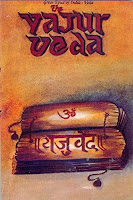The Vedas are a collection of ancient sacred texts revered in Hinduism, considered to be the oldest scriptures of the religion. The word "Veda" is derived from the Sanskrit root "vid," which means "knowledge" or "to know." The Vedas are believed to be divinely revealed knowledge passed down orally through generations of sages and seers before eventually being written down.
Here's a detailed explanation of the Vedas:
1. Classification : The Vedas are classified into four main texts:
- Rigveda : The oldest of the Vedas, composed of hymns (mantras) addressed to various deities and natural forces. It is divided into ten books, known as Mandalas.
- Samaveda : Consists primarily of verses (saman) from the Rigveda set to music for use in rituals and ceremonies.
- Yajurveda : Contains prose and verse formulas used by priests (yajniki) during sacrificial rituals (yajnas). It is further divided into the Shukla (White) and Krishna (Black) Yajurveda.
- Atharvaveda : Comprises hymns and spells for healing, protection, and everyday life. It includes incantations for various purposes and reflects a more folkloric aspect of Vedic culture.
2. Contents : The Vedas cover a wide range of topics, including prayers, rituals, philosophy, cosmology, morality, and societal duties. They contain hymns dedicated to various deities, descriptions of rituals and sacrifices, philosophical speculations on the nature of reality (Brahman), and discussions on ethical conduct and social order.
3. Language : The Vedas are written in Vedic Sanskrit, an ancient Indo-Aryan language. The language and style of the Vedas are highly poetic and symbolic, often employing metaphorical and allegorical language to convey profound spiritual truths.
4. Authorship : According to Hindu tradition, the Vedas are considered to be apauruṣeya, meaning "not of human origin." They are believed to be revealed directly by the divine to ancient sages and seers known as Rishis during deep states of meditation and contemplation.
5. Transmission : The Vedas were originally transmitted orally from teacher (guru) to disciple (shishya) through a process of memorization and recitation. This oral tradition continued for centuries before the texts were eventually written down to preserve them for future generations.
6. Significance : The Vedas hold immense religious, cultural, and spiritual significance in Hinduism. They are regarded as the ultimate authority on matters of religious and philosophical knowledge and form the basis of Hindu rituals, ceremonies, and religious practices.
7. Commentaries and Interpretations : Over the centuries, numerous commentaries (Shakhas) and interpretations (Brahmanas, Aranyakas, Upanishads) have been written to explain the meaning and significance of the Vedas. These texts further elaborate on the rituals, philosophical concepts, and spiritual teachings found in the Vedas.
In summary, the Vedas represent the foundational scriptures of Hinduism, embodying the spiritual wisdom and cultural heritage of ancient India. They continue to inspire and guide millions of Hindus worldwide in their spiritual journey and quest for truth.






